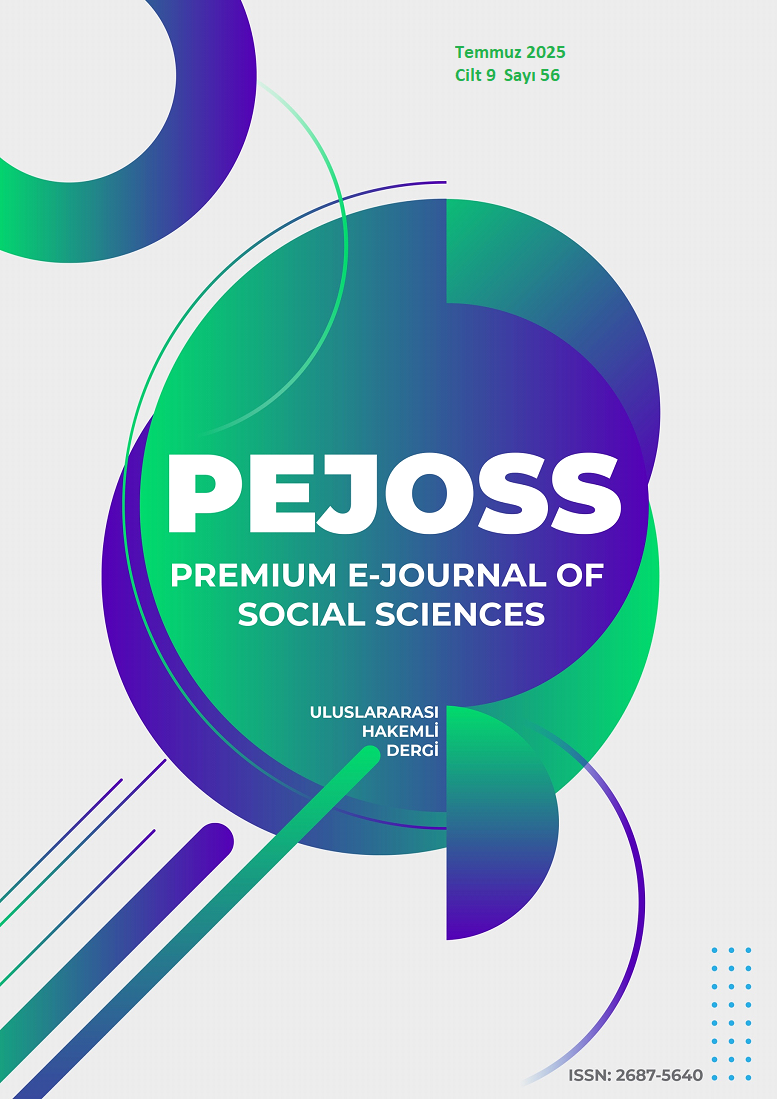The Impact of Post-Pandemic Digital Transformation on Labor Markets
DOI:
https://doi.org/10.5281/zenodo.16730304Keywords:
Digital transformation, remote work, artificial intelligence, reskilling, labor marketAbstract
This research quantitatively investigates the structural transformations in labor markets triggered in the post-pandemic era by remote or hybrid working arrangements, automation investments, and artificial-intelligence applications. Drawing on the statistics presented in the World Economic Forum’s The Future of Jobs reports for 2020, 2023, and 2025, the research aims to uncover sector-level employment shifts and the prevalence of newly demanded skills. To this end, the reports’ micro-survey data were integrated with ILOSTAT and OECD sectoral employment series and the World Bank’s Digital Adoption Index scores, yielding a balanced panel data set covering 12 sectors across three years. Fixed-effects Driscoll–Kraay estimation reveals that a ten-percentage-point rise in the share of remote/hybrid work expands employment by 0.9 percent, while each one-unit increase in the digital-transformation index boosts employment by 1.5 percent. Conversely, a 10 percent increase in the artificial-intelligence investment ratio contracts employment by 0.8 percent in the short term; however, an equivalent improvement in reskilling–upskilling capacity more than offsets this loss, generating a net 2.1 percent expansion. The findings show chronic skill mismatches in the manufacturing and energy sectors and highlight the urgency of national reskilling funds, robust broadband infrastructure, and inclusive social-protection mechanisms. The research provides evidence-based recommendations for policymakers and firms to craft human-centered digital-transformation strategies, and it advocates sector-university micro-accreditation programs, tax-incentivized training funds, and lifelong-learning-oriented curriculum reforms to bridge skill gaps. Policies that enhance worker well-being are emphasized throughout.
Downloads
References
Akar, İ., & Meçik, O. (2021). Çalışma yaşamında yenilikler: Pandemi ile dijitalleşme deneyimi. Journal of Life Economics, 8(4), 403–411. https://doi.org/10.15637/jlecon.997589
Alauddin, F. D. A., Aman, A., Ghazali, M. F., & Daud, S. (2025). The influence of digital platforms on gig workers: A systematic literature review. Heliyon, 11(1), e41491. https://doi.org/10.1016/j.heliyon. 2024.e41491
Aykaç, M., & Kaya, S. (2024). İşgücü piyasasında yaşanan dönüşümler: Standart dışı istihdam ve çalışan yoksulluğu ilişkisi. Sosyoekonomi, 32(62), 413–453. https://doi.org/10.17233/sosyoekonomi.2024. 04.20
Battisti, E., Alfiero, S., & Leonidou, E. (2022). Remote working and digital transformation during the COVID-19 pandemic: Economic–financial impacts and psychological drivers for employees. Journal of Business Research, 150, 38–50. https://doi.org/10.1016/j.jbusres.2022.06.010
Cao, X., Zhang, D., & Huang, L. (2022). The impact of the COVID-19 pandemic on the behavior of online gig workers. Manufacturing & Service Operations Management, 24(5), 2611–2628. https://doi.org/ 10.1287/msom.2022.1113
Carnevale, J. B., & Hatak, I. (2020). Employee adjustment and well-being in the era of COVID-19: Implications for human resource management. Journal of Business Research, 116, 183–187. https://doi.org/10.1016/j.jbusres.2020.05.037
Chen, C., Wang, S., Yao, S., & Lin, Y. (2023). Does digital transformation increase labor income share? Evidence from a resource reallocation perspective. Economic Modelling, 128, 106474. https://doi.org/ 10.1016/j.econmod.2023.106474
Cirillo, V., Mina, A., & Ricci, A. (2024). Digital technologies, labor market flows and training: Evidence from Italian employer–employee data. Technological Forecasting and Social Change, 209, 123735. https://doi.org/10.1016/j.techfore.2024.123735
Çelen, A. İ. (2024). Dijital ekonomide işgücü piyasası: İşgücü talebinin vasıf boyutunda yine, yeni ve yeni baştan dönüşümü. Biga İktisadi ve İdari Bilimler Fakültesi Dergisi, 5(2), 130–145.
Dingel, J. I., & Neiman, B. (2020). How many jobs can be done at home? Journal of Public Economics, 189, 104235. https://doi.org/10.1016/j.jpubeco.2020.104235
Gathmann, C., Kagerl, C., Pohlan, L., & Roth, D. (2024). The pandemic push: Digital technologies and workforce adjustments. Labour Economics, 89, 102541. https://doi.org/10.1016/j.labeco.2024.102541
Gao, J., Li, Z., Nguyen, T., & Zhang, W. (2025). Digital transformation and enterprise employment. International Review of Economics & Finance, 99, 104036. https://doi.org/10.1016/j.iref. 2025.104036
Gücenmez, T. (2023). Türkiye’de dijital dönüşümün iş gücü piyasalarına etkisi ve gelir dağılımı ilişkisi. Kahramanmaraş Sütçü İmam Üniversitesi Sosyal Bilimler Dergisi, 20(3), 995–1005. https://doi.org/ 10.33437/ksusbd.1361092
Han, Y., Yang, J., Ying, L., & Niu, Y. (2024). The impact of corporate digital transformation on labor employment. Finance Research Letters, 60, 104888. https://doi.org/10.1016/j.frl.2023.104888
Huang, Y. (2024). Digital transformation of enterprises: Job creation or job destruction? Technological Forecasting and Social Change, 208, 123733. https://doi.org/10.1016/j.techfore.2024.123733
Jahan, N., & Zhou, Y. (2023). Covid-19 and digital inclusion: Impact on employment. Journal of Digital Economy, 2, 190–203. https://doi.org/10.1016/j.jdec.2024.01.003
Li, W., Yang, X., & Yin, X. (2024). Digital transformation and labor upgrading. Pacific-Basin Finance Journal, 83, 102280. https://doi.org/10.1016/j.pacfin.2024.102280
Lu, Z., Wang, S., Ling, W., & Guo, Y. (2023). Gig work and mental health during the Covid-19 pandemic: A gendered examination of comparisons with regular employment and unemployment. Social Science & Medicine, 337, 116281. https://doi.org/10.1016/j.socscimed.2023.116281
McClure, P. K. (2018). “You’re fired,” says the robot: The rise of automation in the workplace, technophobes, and fears of unemployment. Social Science Computer Review, 36(2), 139–156. https://doi.org/10.1177/0894439317698637
Rusakova, T., & Saychenko, O. (2022). Virtual labor market during the COVID-19 pandemic and their impact on transport industry. Transportation Research Procedia, 63, 2021–2029. https://doi.org/ 10.1016/j.trpro.2022.06.225
Sarıipek, D. B., Cerev, G., & Ayhan, E. E. (2023). İşgücü piyasasında pandemi sonrası “yeni normal”; hibrit çalışma ve iş-yaşam dengesi. İnsan ve İnsan, 10(35), 11–27. https://doi.org/10.29224/ insanveinsan.1189607
World Economic Forum. (2020). The Future of Jobs Report 2020. World Economic Forum. https://www.weforum.org/reports/the-future-of-jobs-report-2020/
World Economic Forum. (2023). The Future of Jobs Report 2023. World Economic Forum. https://www.weforum.org/reports/the-future-of-jobs-report-2023/
World Economic Forum. (2025). The future of jobs report 2025. World Economic Forum. https://www.weforum.org/reports/the-future-of-jobs-report-2025/
Downloads
Published
How to Cite
Issue
Section
License
Copyright (c) 2025 Premium e-Journal of Social Science (PEJOSS)

This work is licensed under a Creative Commons Attribution 4.0 International License.


